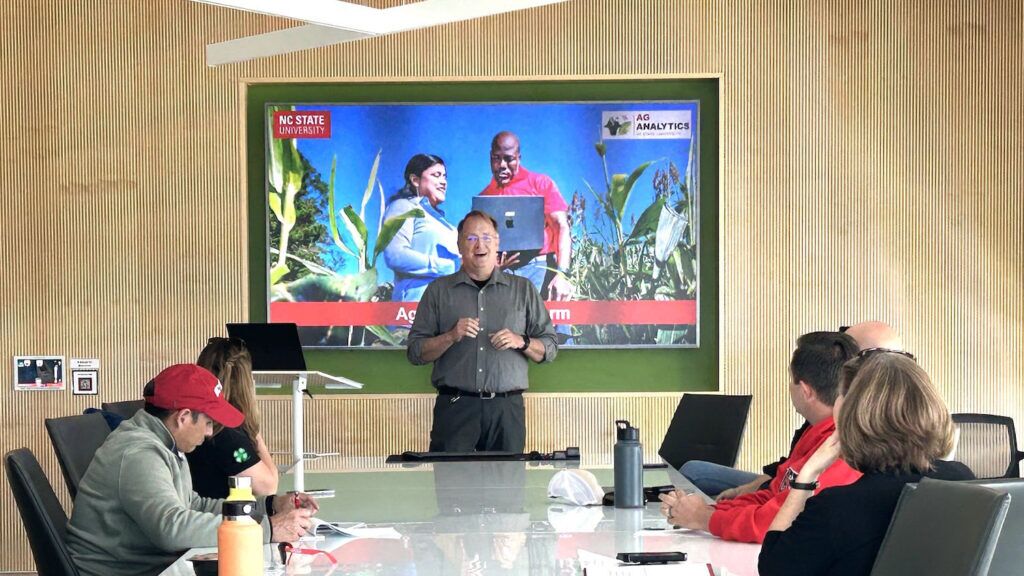$100K from Giant supports cleaner water and local farm practices – The Herald-Mail

Report on The GIANT Company’s Contribution to Sustainable Development in the Chesapeake Bay Region
Executive Summary
The GIANT Company has allocated a $100,000 donation to The Nature Conservancy to advance regenerative agriculture within the Chesapeake Bay watershed. This initiative directly supports several United Nations Sustainable Development Goals (SDGs) by promoting innovative farming practices that enhance environmental quality and support sustainable food systems. The funding targets farmers in Delaware, Pennsylvania, and Maryland, fostering a partnership critical for achieving regional sustainability targets.
Alignment with Sustainable Development Goals (SDGs)
The project is strategically aligned with multiple SDGs, demonstrating a commitment to integrated sustainable development:
- SDG 2 (Zero Hunger): By supporting farmers with new technology and practices, the initiative strengthens sustainable food production systems and promotes resilient agriculture.
- SDG 6 (Clean Water and Sanitation): The primary objective is to improve water quality in local streams and the Chesapeake Bay by reducing agricultural runoff.
- SDG 12 (Responsible Consumption and Production): The partnership fosters sustainable production patterns within the local food supply chain, connecting a major grocer with over 100 local farms.
- SDG 14 (Life Below Water): Reducing fertilizer pollution directly contributes to the health and restoration of the Chesapeake Bay’s aquatic ecosystems.
- SDG 15 (Life on Land): Regenerative practices enhance soil health, reduce erosion, and promote biodiversity on agricultural lands.
- SDG 17 (Partnerships for the Goals): The collaboration between The GIANT Company (private sector) and The Nature Conservancy (non-profit organization) exemplifies a multi-stakeholder partnership to achieve common sustainability objectives.
Strategic Objectives and Supported Practices
The funding is designated to help farmers implement and test innovative agricultural practices with the goal of achieving positive environmental and economic outcomes. The core objectives are to find solutions that benefit both agricultural productivity and nature.
- Reduce Tillage: Implementing low-till or no-till farming methods to improve soil structure, increase water retention, and sequester carbon, directly supporting SDG 15 and SDG 13 (Climate Action).
- Promote Multi-Species Cover Crops: Encouraging the use of diverse cover crops to protect and enrich the soil, prevent erosion, and enhance biodiversity, contributing to SDG 2 and SDG 15.
- Reduce Fertilizer Application: Adopting precision agriculture and other techniques to minimize fertilizer use, thereby reducing nutrient runoff into waterways, a key action for SDG 6 and SDG 14.
Project Impact and Stakeholder Statements
This grant is expected to yield significant benefits for regional sustainability by creating a model for corporate support of environmental stewardship in agriculture.
- The GIANT Company: Rebecca Lupfer, Chief Merchant, emphasized the company’s reliance on agricultural partners and framed the initiative as a way to “make a difference in helping to heal our planet,” aligning with corporate responsibility goals under SDG 12.
- The Nature Conservancy: Amy Jacobs, Director of the Chesapeake Bay Program, highlighted that the grant supports farmers in testing practices that “benefit their bottom line and provide cleaner water,” underscoring the project’s dual focus on achieving economic viability (SDG 2) and environmental protection (SDG 6).
Analysis of Sustainable Development Goals in the Article
1. Which SDGs are addressed or connected to the issues highlighted in the article?
-
SDG 2: Zero Hunger
- The article discusses supporting a “thriving farming industry” and regenerative agriculture practices. This directly relates to sustainable food production systems, which are essential for ensuring long-term food security. The GIANT Company’s role as a grocer that partners with local farms further strengthens this connection.
-
SDG 6: Clean Water and Sanitation
- This is a primary focus of the article. The stated goal of the initiative is to “improve water quality in local streams… and the Chesapeake Bay” by reducing agricultural runoff, particularly from fertilizer application.
-
SDG 14: Life Below Water
- The Chesapeake Bay is a major coastal estuary. The initiative aims to reduce land-based pollution, specifically nutrient pollution from fertilizers, which is a major threat to marine and coastal ecosystems. Improving the Bay’s water quality directly contributes to the health of life below water.
-
SDG 15: Life on Land
- The article highlights regenerative agriculture practices such as reducing tillage and planting cover crops. These methods are designed to improve soil health, prevent erosion, and restore the terrestrial ecosystems of the farmlands within the Chesapeake Bay watershed.
-
SDG 17: Partnerships for the Goals
- The entire initiative described is a partnership between a private sector entity (The GIANT Company) and a civil society organization (The Nature Conservancy). This collaboration to achieve common environmental and agricultural goals is a clear example of SDG 17 in action.
2. What specific targets under those SDGs can be identified based on the article’s content?
-
Target 2.4
- “By 2030, ensure sustainable food production systems and implement resilient agricultural practices…” The article’s focus on “regenerative agriculture practices” like reduced tillage and cover crops directly aligns with creating resilient and sustainable food systems that improve land and soil quality.
-
Target 6.3
- “By 2030, improve water quality by reducing pollution…” The project’s explicit goal to “improve water quality” by helping farmers “reduce fertilizer application” is a direct effort to reduce pollution from agricultural sources.
-
Target 14.1
- “By 2025, prevent and significantly reduce marine pollution of all kinds, in particular from land-based activities, including… nutrient pollution.” The initiative’s effort to reduce fertilizer use in the Chesapeake Bay watershed is a direct action to curb nutrient pollution flowing into a major coastal water body.
-
Target 15.3
- “By 2030, combat desertification, restore degraded land and soil…” The regenerative practices mentioned, such as reducing tillage and using cover crops, are key strategies for restoring the health and quality of degraded farmland soil.
-
Target 17.17
- “Encourage and promote effective public, public-private and civil society partnerships…” The collaboration between The GIANT Company (private sector) and The Nature Conservancy (civil society) to fund and implement these agricultural practices exemplifies this target.
3. Are there any indicators mentioned or implied in the article that can be used to measure progress towards the identified targets?
-
Adoption of Regenerative Agriculture Practices
- The article states the funding will “support farmers in adopting new technology and implementing innovative practices.” An implied indicator is the number of farmers or acres of farmland that adopt practices like reduced tillage, multi-species cover crops, and reduced fertilizer application. This would measure progress towards Target 2.4 and 15.3.
-
Improved Water Quality
- The primary goal is to “improve water quality in local streams… and the Chesapeake Bay.” This implies that water quality monitoring (e.g., measuring levels of nitrogen and phosphorus from fertilizer runoff) would be a key indicator of success, relating directly to Target 6.3 and 14.1.
-
Reduction in Fertilizer Application
- The article explicitly mentions the goal to “reduce fertilizer application.” A direct indicator would be the measured decrease in the volume or intensity of fertilizer used by participating farmers, which contributes to Target 6.3 and 14.1.
-
Financial Investment in Partnerships
- The “$100,000 donation” is a concrete indicator of a private-civil society partnership in action. The amount of funding dedicated to such collaborations can be used to measure the commitment to Target 17.17.
SDGs, Targets, and Indicators Summary
| SDGs | Targets | Indicators |
|---|---|---|
| SDG 2: Zero Hunger | 2.4: Ensure sustainable food production systems and implement resilient agricultural practices. | Adoption rate of regenerative agriculture practices (e.g., number of acres under reduced tillage, use of cover crops). |
| SDG 6: Clean Water and Sanitation | 6.3: Improve water quality by reducing pollution. | Measured improvements in water quality in local streams and the Chesapeake Bay (e.g., reduced nutrient levels). |
| SDG 14: Life Below Water | 14.1: Prevent and significantly reduce marine pollution, especially from land-based activities like nutrient pollution. | Measured reduction in fertilizer application by farmers in the watershed. |
| SDG 15: Life on Land | 15.3: Restore degraded land and soil. | Implementation of practices that improve soil health (e.g., reduced tillage, planting of multi-species cover crops). |
| SDG 17: Partnerships for the Goals | 17.17: Encourage and promote effective public-private and civil society partnerships. | The existence and financial value of the partnership ($100,000 donation from The GIANT Company to The Nature Conservancy). |
Source: heraldmailmedia.com

What is Your Reaction?
 Like
0
Like
0
 Dislike
0
Dislike
0
 Love
0
Love
0
 Funny
0
Funny
0
 Angry
0
Angry
0
 Sad
0
Sad
0
 Wow
0
Wow
0
















































/environment-climate-change-and-health-(ech)/water-sanitation-hygiene-and-health-(wsh)/landfill-tuvalu-36092.tmb-1200v.jpg?sfvrsn=5c21fe40_1#)

.jpg.webp?itok=0ZsAnae9#)
























